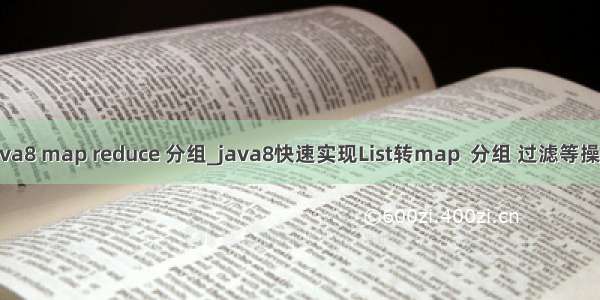
原文地址:/lu930124/article/details/77595585
利用java8新特性,可以用简洁高效的代码来实现一些数据处理。
定义1个Apple对象:
public class Apple {
private Integer id;
private String name;
private BigDecimal money;
private Integer num;
public Apple(Integer id, String name, BigDecimal money, Integer num) {
this.id = id;
this.name = name;
this.money = money;
this.num = num;
}
}
添加一些测试数据:
List<Apple> appleList = new ArrayList<>();//存放apple对象集合
Apple apple1 = new Apple(1,"苹果1",new BigDecimal("3.25"),10);
Apple apple12 = new Apple(1,"苹果2",new BigDecimal("1.35"),20);
Apple apple2 = new Apple(2,"香蕉",new BigDecimal("2.89"),30);
Apple apple3 = new Apple(3,"荔枝",new BigDecimal("9.99"),40);
appleList.add(apple1);
appleList.add(apple12);
appleList.add(apple2);
appleList.add(apple3);
1、分组
List里面的对象元素,以某个属性来分组,例如,以id分组,将id相同的放在一起:
//List 以ID分组 Map<Integer,List<Apple>>
Map<Integer, List<Apple>> groupBy = appleList.stream().collect(Collectors.groupingBy(Apple::getId));
System.err.println("groupBy:"+groupBy);
{1=[Apple{id=1, name='苹果1', money=3.25, num=10}, Apple{id=1, name='苹果2', money=1.35, num=20}], 2=[Apple{id=2, name='香蕉', money=2.89, num=30}], 3=[Apple{id=3, name='荔枝', money=9.99, num=40}]}
2、List转Map
id为key,apple对象为value,可以这么做:
/**
* List -> Map
* 需要注意的是:
* toMap 如果集合对象有重复的key,会报错Duplicate key ....
* apple1,apple12的id都为1。
* 可以用 (k1,k2)->k1 来设置,如果有重复的key,则保留key1,舍弃key2
*/
Map<Integer, Apple> appleMap = appleList.stream().collect(Collectors.toMap(Apple::getId, a -> a,(k1,k2)->k1));
打印appleMap
{1=Apple{id=1, name='苹果1', money=3.25, num=10}, 2=Apple{id=2, name='香蕉', money=2.89, num=30}, 3=Apple{id=3, name='荔枝', money=9.99, num=40}}
3、过滤Filter
从集合中过滤出来符合条件的元素:
//过滤出符合条件的数据
List<Apple> filterList = appleList.stream().filter(a -> a.getName().equals("香蕉")).collect(Collectors.toList());
System.err.println("filterList:"+filterList);
[Apple{id=2, name='香蕉', money=2.89, num=30}]
4.求和
将集合中的数据按照某个属性求和:
//计算 总金额
BigDecimal totalMoney = appleList.stream().map(Apple::getMoney).reduce(BigDecimal.ZERO, BigDecimal::add);
System.err.println("totalMoney:"+totalMoney); //totalMoney:17.48
Integer:
//计算 数量int sum = appleList.stream().mapToInt(Apple::getNum).sum();System.err.println("sum:"+sum); //sum:100
5.查找流中最大 最小值
Collectors.maxBy 和 Collectors.minBy 来计算流中的最大或最小值。
Optional<Dish> maxDish = Dish.menu.stream().
collect(Collectors.maxBy(paring(Dish::getCalories)));
maxDish.ifPresent(System.out::println);
Optional<Dish> minDish = Dish.menu.stream().
collect(Collectors.minBy(paring(Dish::getCalories)));
minDish.ifPresent(System.out::println);
6.去重
import static paringLong;
import static java.util.stream.Collectors.collectingAndThen;
import static java.util.stream.Collectors.toCollection;
// 根据id去重
List<Person> unique = appleList.stream().collect(
collectingAndThen(
toCollection(() -> new TreeSet<>(comparingLong(Apple::getId))), ArrayList::new)
);
7.
将某个属性转为新的list
List<String> orders=list.stream().map(User::getOrder).collect(Collectors.toList());
下表展示 Collectors 类的静态工厂方法。
工厂方法 返回类型 作用
toList List<T> 把流中所有项目收集到一个 List
toSet Set<T> 把流中所有项目收集到一个 Set,删除重复项
toCollection Collection<T> 把流中所有项目收集到给定的供应源创建的集合menuStream.collect(toCollection(), ArrayList::new)
counting Long 计算流中元素的个数
sumInt Integer 对流中项目的一个整数属性求和
averagingInt Double 计算流中项目 Integer 属性的平均值
summarizingInt IntSummaryStatistics 收集关于流中项目 Integer 属性的统计值,例如最大、最小、 总和与平均值
joining String 连接对流中每个项目调用 toString 方法所生成的字符串collect(joining(", "))
maxBy Optional<T> 一个包裹了流中按照给定比较器选出的最大元素的 Optional, 或如果流为空则为 Optional.empty()
minBy Optional<T> 一个包裹了流中按照给定比较器选出的最小元素的 Optional, 或如果流为空则为 Optional.empty()
reducing 归约操作产生的类型 从一个作为累加器的初始值开始,利用 BinaryOperator 与流 中的元素逐个结合,从而将流归约为单个值累加int totalCalories = menuStream.collect(reducing(0, Dish::getCalories, Integer::sum));
collectingAndThen 转换函数返回的类型 包裹另一个收集器,对其结果应用转换函数int howManyDishes = menuStream.collect(collectingAndThen(toList(), List::size))
groupingBy Map<K, List<T>> 根据项目的一个属性的值对流中的项目作问组,并将属性值作 为结果 Map 的键
partitioningBy Map<Boolean,List<T>> 根据对流中每个项目应用谓词的结果来对项目进行分区
















